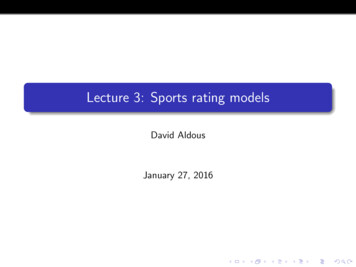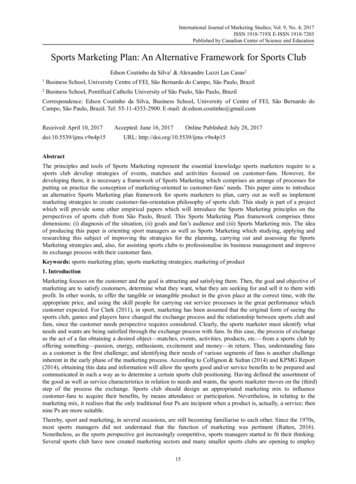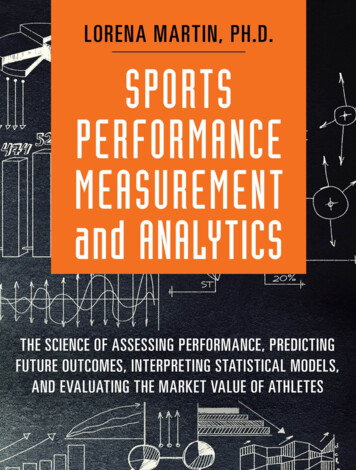
Transcription
Lecture 3: Sports rating modelsDavid AldousJanuary 27, 2016
Sports are a popular topic for course projects – usually involvingdetails of some specific sport and statistical analysis of data.In this lecture we imagine some non-specific sport; either a teamsport – (U.S.) football, baseball, basketball, hockey; soccer cricket –or an individual sport or game – tennis, chess, boxing.We consider only sports with matches between twoteams/individuals. But similar ideas work where there are manycontestants – athletics, horse racing, automobile racing, online videogames.Let me remind you of three things you already know about sports.Reminder 1. Two standard “centralized” ways to schedule matches:league or tournament.
2014–15 Premier 3241872Man City382477833845793Arsenal382297713635754Man nsea City38168144649-3569Stoke City3815914484535410Crystal st Ham381211154447-34713West Brom381111163851-134414Leicester nderland38717143153-223817Aston Villa38108203157-263818Hull City38811193351-183519Burnley FC38712192853-253320QPR3886244273-3130Show lessBarclays Premier League table, current & previous e.htmlPremier League
These schemes are clearly “fair” and produce a “winner”, though havetwo limitationsLimited number of teams.Start anew each year/tournament.Require central organization – impractical for for games (chess,tennis) with many individual contestants.Reminder 2. In most sports the winner is decided by point difference.One could model point difference but we won’t. For simplicity we willassume matches always end in win/lose, no ties.Reminder 3. A main reason why sports are interesting is that theoutcome is uncertain. It makes sense to consider the probability of teamA winning over team B. In practice one can do this by looking atgambling odds [next slide]. Another lecture will discuss data and theoryconcerning how probabilities derived from gambling odds change overtime.
Winner of 2015-16 season Superbowl – gambling odds at start of season.PredictWiseDerived Betfair PriceBetfair BackBetfair LaySeattle SeahawksOutcome18 % 0.1715.805.90Green Bay Packers14 % 0.1377.207.40Indianapolis Colts9% 0.08911.0011.50New England Patriots8% 0.07712.5013.50Denver Broncos6% 0.06315.5016.50Dallas Cowboys5% 0.04721.0022.00Baltimore Ravens4% 0.03826.0027.00Philadelphia Eagles3% 0.03626.0030.00Pittsburgh Steelers3% 0.03528.0030.00Miami Dolphins3% 0.03329.0032.00Arizona Cardinals3% 0.02636.0040.00Cincinnati Bengals2% 0.02440.0042.00Kansas City Chiefs2% 0.02244.0046.00Carolina Panthers2% 0.02144.0055.00Atlanta Falcons2% 0.02048.0050.00New Orleans Saints2% 0.01950.0055.00Buffalo Bills2% 0.01850.0065.00Detroit Lions2% 0.01755.0060.00New York Giants2% 0.01755.0060.00Minnesota Vikings2% 0.01755.0065.00San Diego Chargers1% 0.01660.0065.00
Obviously the probability A beats B depends on the strengths of theteams – a better team is likely to beat a worse team. So the problemsestimate the strengths of A and Bestimate the probability that A will beat Bmust be closely related. This lecture talks about two ideas for makingsuch estimates which have been well studied. However the connectionbetween them has not been so well studied, and is suitable forsimulation-style projects.Terminology. I write strength for some hypothetical objective numericalmeasure of how good a team is – which we can’t observe – and ratingfor some number we can calculate by some formula based on past matchresults. Ratings are intended as estimates of strengths.
Idea 1: The basic probability model.Each team A has some “strength” xA , a real number. When teams A andB playP(A beats B) W (xA xB )for a specified “win probability function” W satisfying the conditionsW : R (0, 1) is continuous, strictly increasingW ( x) W (x) 1;lim W (x) 1.x Implicit in this setup, as mentioned beforeeach game has a definite winner (no ties);no home field advantage, though this is easily incorporated bymaking the win probability be of the form W (xA xB );not considering more elaborate modeling of point differenceand alsostrengths do not change with time.(1)
Some comments on the math model.P(A beats B) W (xA xB )W : R (0, 1) is continuous, strictly increasingW ( x) W (x) 1;lim W (x) 1.x There is a reinterpretation of this model, as follows. Consider thealternate model in which the winner is determined by point difference,and suppose the random point difference D between two teams of equalstrength has some (necessarily symmetric) continuous distribution notdepending on their common strength, and then suppose that a differencein strength has the effect of increasing team A’s points by xA xB . Thenin this alternate modelP(A beats B) P(D xA xB 0) P( D xA xB ) P(D xA xB ).So this is the same as our original model in which we take W as thedistribution function of D.
This basic probability model has undoubtedly been re-invented manytimes; in the academic literature it seems to have developed “sideways”from the following type of statistical problem. Suppose we wish to rank aset of movies A, B, C , . . . by asking people to rank (in order ofpreference) the movies they have seen. Our data is of the form(person 1): C , A, E(person 2): D, B, A, C(person 3): E , D.One way to produce a consensus ranking is to consider each pair (A, B)of movies in turn. Amongst the people who ranked both movies, somenumber i(A, B) preferred A and some number i(B, A) preferred B. Nowreinterpret the data in sports terms: team A beat B i(A, B) times andlost to team B i(B, A) times. Within the basic probability model (withsome specified W ) one can calculate MLEs of strengths xA , xB , . . . whichimply a ranking order.
This method, with W the logistic function (discussed later), is called theBradley-Terry model, from the 1952 paper Rank analysis of incompleteblock designs: I. The method of paired comparisons by R.A. Bradley andM.E. Terry.An account of the basic Statistics theory (MLEs, confidence intervals,hypothesis tests, goodness-of-fit tests) is treated in Chapter 4 of H.A.David’s 1988 monograph The Method of Paired Comparisons.So one can think of Bradley-Terry as a sports model as follows: takedata from some past period, calculate MLEs of strengths, use to predictfuture win probabilities.
Considering Bradley-Terry as a sports model:positives: allows unstructured schedule; use of logistic makes algorithmic computation straightforward.negatives: use of logistic completely arbitrary: assertingif P(i beats j) 2/3, P(j beats k) 2/3 then P(i beats k) 4/5as a universal fact seems ridiculous; by assuming unchanging strengths, it gives equal weight to past as torecent results; need to recompute MLEs after each match.The Bradley-Terry model could be used for interesting course projects –take the Premier league data and ask what is the probability that Chelseawas actually the best team in 2014-15?.
Reminder 4. Another aspect of what makes sports interesting to aspectator is that strengths of teams change over time – if your team didpoorly last year, then you can hope it does better this year.In the context of the Bradley-Terry model, one can extend the model toallow changes in strengths. Seem to be about 2-3 academic papers peryear which introduce some such extended model and analyze somespecific sports data. Possible source of course projects – apply todifferent sport or to more recent data.
Idea 2: Elo-type rating systems [show site](not ELO). The particular type of rating systems we study are knownloosely as Elo-type systems and were first used systematically in chess.The Wikipedia page Elo rating system is quite informative about thehistory and practical implementation. What I describe here is anabstracted “mathematically basic” form of such systems.Each player i is given some initial rating, a real number yi . When player iplays player j, the ratings of both players are updated using a function Υ(Upsilon)if i beats j then yi yi Υ(yi yj ) and yj yj Υ(yi yj )if i loses to j then yi yi Υ(yj yi ) and yj yj Υ(yj yi ) .(2)Note that the sum of all ratings remains constant; it is mathematicallynatural to center so that this sum equals zero.
: ame*is*won*by*three*goals,*and*by*3/4 (N ther*from*the*chart*or*the*following*formula:We* *1*/*(10(Jdr/400)* ints*for*a*team*playing*at*home.
Schematic of one player’s ratings after successive matches. The indicate each opponent’s rating.rrating6rrrrr
Math comments on the Elo-type rating algorithm.We require the function Υ(u), u to satisfy the qualitativeconditionsΥ : R (0, ) is continuous, strictly decreasing, and lim Υ(u) 0.u (3)We will also impose a quantitative conditionκΥ : sup Υ0 (u) 1.(4)uTo motivate the latter condition, the rating updates when a player with(variable) strength x plays a player of fixed strength y arex x Υ(x y ) and x x Υ(y x)and we want these functions to be increasing functions of the starting strengthx.Note that if Υ satisfies (3) then so does cΥ for any scaling factor c 0. Sogiven any Υ satisfying (3) with κΥ we can scale to make a function where(4) is satisfied.
The logistic distribution functionF (x) : ex, x 1 exis a common choice for the “win probability” function W (x) in the basicprobability model; and its complement1 F (x) F ( x) 1, x 1 exis a common choice for the “update function shape” Υ(x) in Elo-typerating systems. That is, one commonly uses Υ(x) cF ( x).possible W (x)possible Υ(x)Whether this is more than a convenient choice is a central issue in thistopic.
Elo is an algorithm for producing ratings (and therefore rankings) which(unlike Bradley-Terry) does not assume any probability model. Itimplicitly attempts to track changes in strength and puts greater weighton more recent match results.How good are Elo-type algorithms? This is a subtle question – weneed touse Elo to make predictionschoose how to measure their accuracycompare accuracy with predictions from some other ranking/ratingscheme (such as Bradley-Terry or gambling odds).The simplest way to compare schemes would be to look at matcheswhere the different schemes ranked the teams in opposite ways, and seewhich team actually won. But this is not statistically efficient [board].Better to compare schemes which predict probabilities.Although the Elo algorithm does not say anything explicitly aboutprobability, we can argue that it implicitly does predict winningprobabilities.
A math connection between the probability model and the ratingalgorithm.Consider n teams with unchanging strengths x1 , . . . , xn , with matchresults according to the basic probability model with win probabilityfunction W , and ratings (yi ) given by the update rule with updatefunction Υ. When team i plays team j, the expectation of the ratingchange for i equalsΥ(yi yj )W (xi xj ) Υ(yj yi )W (xj xi ).So consider the case where the functions Υ and W are related byΥ(u)/Υ( u) W ( u)/W (u), u .In this case(*) If it happens that the difference yi yj in ratings of twoplayers playing a match equals the difference xi xj instrengths then the expectation of the change in ratingdifference equals zerowhereas if unequal then (because Υ is decreasing) the expectation of(yi yj ) (xi xj ) is closer to zero after the match than before.(5)
Υ(u)/Υ( u) W ( u)/W (u), u .(6)These observations suggest that, under relation (6), there will be atendency for player i’s rating yi to move towards its strength xi thoughthere will always be random fluctuations from individual matches. So ifwe believe the basic probability model for some given W , then in a ratingsystem we should use an Υ that satisfies (6).Recall that in the probability model we can center the strengths so thatPPi xi 0, and similarly we will initialize ratings so thati yi 0.What is the solution of (6) for unknown Υ?This can be viewed as the setup for amathematician/physicist/statistician joke.
Problemsolve Υ(u)/Υ( u) W ( u)/W (u), u .Solutionphysicist (Elo): Υ(u) cW ( u)mathematician: Υ(u) W ( u)φ(u) for arbitrary symmetric φ(·).pstatistician: Υ(u) c W ( u)/W (u) (variance-stabilizing φ).These answers are all “wrong” for different reasons. And so in fact it’shard to answer “what Υ to use?”However we can work backwards; when people use the “complement oflogistic” as the update function Υ, we can use (6) to argue that they areimplicitly imagining the Bradley-Terry with W the logistic function. Sothis gives a way to use Elo ratings to predict win probabilities.
There is a link to my more mathematical write-up of the topic above.There are several related possible simulation projects. For instance,consider a league on n teams, whose strengths has some SD σ, thestrengths change in time via some rule with rate parameter λ. We takethe probability model with logistic W and the update model with functioncΥ for logistic Υ. Study how the optimal value of c depends on (n, σ, λ).
Some other aspects of rating models.1. Recent book “The Science of Ranking and Rating” treats methodsusing undergraduate linear algebra. The lecture in this course in 2014was based more on that book (link on web page).2. People who attempt realistic models of particular sports, using e.g.statistics of individual player performance, believe their models are muchbetter than general-sport methods based only on history of wins/losses orpoint differences. But a recent paper Statistics-free sports predictionclaims that (using more complex prediction schemes) they can do almostas well using only match scores.3. I have talked about comparing different schemes which predictprobabilities – after we see the actual match results, how do we decidewhich scheme is better? I will discuss this in a different context, thelecture on Geopolitics forecasting.4. Both schemes are poor at assessing new players. Xbox Live uses its“TrueSkill ranking system” [show page] which estimates both a ratingand the uncertainty in the rating, as follows.
Here a rating for player i is a pair (µi , σi ), and the essence of the schemeis as follows. When i beats j(i) first compute the conditional distribution of Xi given Xi Xj , whereXi has Normal(µi , σi2 ) distribution(ii) then update i’s rating to the mean and s.d. of that conditionaldistribution.Similarly if i loses to j then i’s rating is updated to the mean and s.d. ofthe conditional distribution of Xi given Xi Xj .Discussion. The authors seem to view this as anapproximation to some coherent Bayes scheme, but to me itfails to engage both ‘‘uncertainty about strength" and‘‘uncertainty about match outcome".So another simulation project is to compare this to other schemes. Notethis implicitly predicts winning probabilities via P(Xi Xj ).
[show slides from previous year lecture]People often think that bookmakers adjust their offered odds so that,whatever the outcome, they never lose money. This just isn’t true. [showESPN article]Finally, there is an interesting paradox involved in designing matches tobe exciting to spectators [board].
Tennessee Titans 0 % 0.002 520.00 600.00 Jacksonville Jaguars 0 % 0.002 450.00 600.00 POLITICS SPORTS NBA Basketball - June 16, 2015 NHL Hockey - June 15, 2015 2015 PGA Golf Championship 2015 Rugby World Cup 2015 MLB World Series











